Bringing ERCs into the INCLUDES National Network (2019)
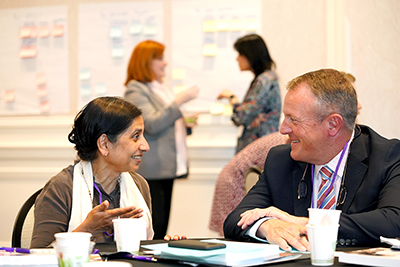
This publication shares the proceedings of the ERC-INCLUDES Capacity Building Institute (CBI). The content may be useful for people who
- participated in the CBI;
- work on diversity goals within National Science Foundation (NSF)-funded Inclusion across the Nation of Communities of Learners of Underrepresented Discoverers in Engineering and Science (INCLUDES) projects, NSF-funded Engineering Research Centers (ERCs), or postsecondary engineering departments;
- seek to increase their understanding of issues surrounding the participation of individuals from different underrepresented backgrounds in INCLUDES projects or ERCs;
- would like to access resources to help make their courses, products, programs, and activities more welcoming and accessible; and/or
- have promising practices to share with others.
About the CBI
The goals of the CBI were to integrate evidence-based broadening participation practices of INCLUDES into the ERCs, share ERC diversity activities and outcomes to inform research and practice of INCLUDES projects, and build a durable collaborative infrastructure for broadening participation in NSF-funded research through the engagement of ERCs with the NSF INCLUDES National Network.
Participants discussed their unique learning goals for the CBI, which included the following:
- Connecting with other participants for collaborative grant writing
- Discovering ways to scale up inclusion practices in specific INCLUDES projects
- Widening the knowledge base of best practices for broadening participation
- Implementing broadening participation strategies utilized by ERCs
- Gathering information to develop a tip sheet or other tools related to diversity and inclusion
- Understanding better ways to recruit and retain underrepresented students
- Learning about meaningful ways to participate in activities of the INCLUDES National Network
- Identifying how to improve opportunities to connect virtually with participants and stakeholders
- Discovering ways to include more engineering activities in outreach activities
- Understanding best practices for engaging current and future STEM faculty to ensure faculty are diverse
- Ensuring educators are welcoming and inclusive in the classroom
- Learning about methods to partner with industry
- Improving project and program accessibility for students with disabilities
- Enhancing the ability to leverage technology to provide mentoring virtually
- Understanding how to encourage underrepresented students to pursue PhDs
- Exploring ways to have a national impact together
About ERC-INCLUDES
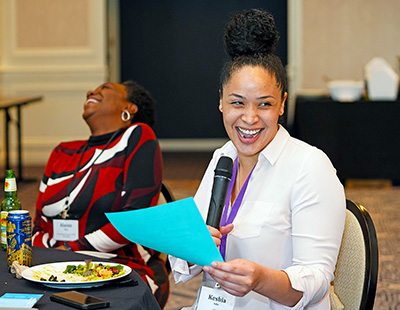
In ERC-INCLUDES, staff of ERCs and INCLUDES Design and Development Launch Pilots (DDLPs), Alliances, and the Coordination Hub will engage to reach objectives to
- Integrate evidence-based broadening participation practices of INCLUDES into the ERCs,
- Share ERC diversity activities and outcomes to inform research/practice of INCLUDES projects, and
- Build a durable collaborative infrastructure for broadening participation in NSF-funded research through the engagement of ERCs with the NSF INCLUDES National Network.
ERC-INCLUDES project activities include the CBI, as well as a community of practice, a website, a multi-media repository of resources available to participants, and the development of a model for bringing a community of NSF-funded projects into the INCLUDES National Network:
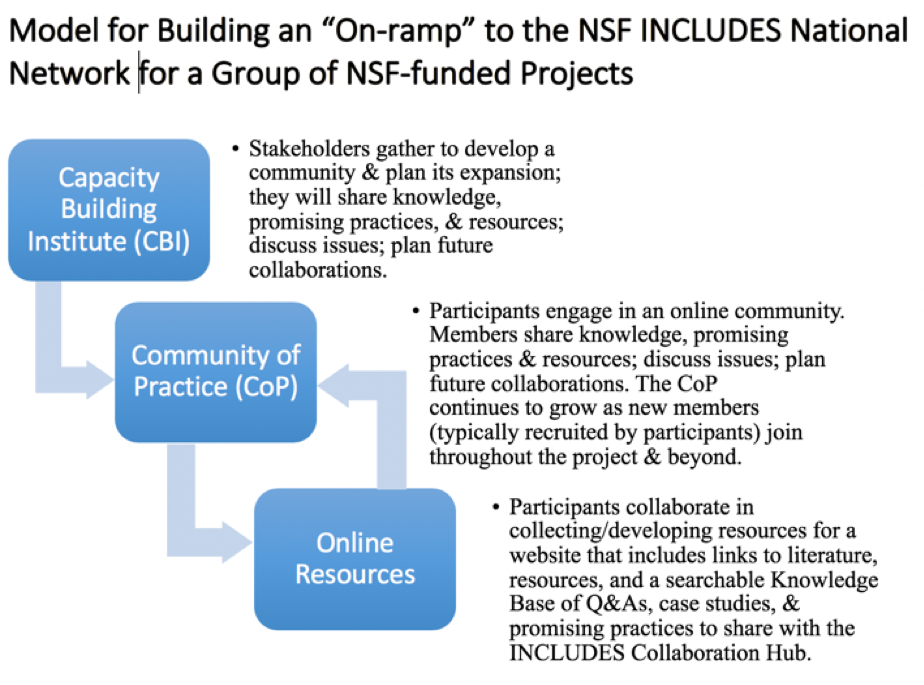
ERC-INCLUDES is funded by the National Science Foundation as a supplement to an existing ERC, the Center for Neurotechnology (CNT), headquartered at the University of Washington in Seattle. The CNT has excelled in the ERC community at including individuals with disabilities, and individuals form other underrepresented groups in research, leadership, and education. The ultimate impact of ERC-INCLUDES will be to increase the successful participation of individuals with diverse characteristics in STEM and improve these fields with their unique perspectives and expertise.
CBI Agenda
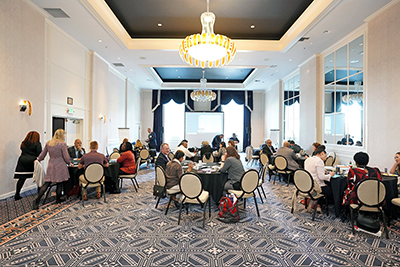
Wednesday, April 3 T12 Social House (4501 12th Ave NE)
7:00–8:30 pm No-host networking reception
Thursday, April 4 Graduate Hotel, Wright Ballroom
8:00–9:00 am Breakfast and networking
9:00–9:20 am Welcome & Overview of ERC-INCLUDES goal, objectives, and activities
Sheryl Burgstahler & Rajesh Rao, University of Washington
9:20–10:10 am Introductions
Sheryl Burgstahler & Scott Bellman, University of Washington
10:10–10:30 am NSF INCLUDES Coordination Hub: Building a National Network to Advance Equity in STEM
Shari Gardner & Kate Goddard, SRI International
10:45–12:30 pm Northeastern U.S.: Best Practices in Broadening Participation
All participants: On Post-it Notes, write promising broadening participation practices that could be implemented in ERCs, INCLUDES projects, and in departments/institutions.
Alaine Allen, University of Pittsburgh
The Keys to STEM Success for Urban Youth
Amy Tuininga, Montclair State University
S-TEAMS Improve Sense of Inclusion for Underrepresented Groups
Michael Smith, National GEM Consortium
UF & the Consortium of Minority Doctoral Scholars Programs Collaborative Best Practices
Aristides Marcano, Delaware State University
Expanding Diversity through the Creation of Learning Opportunities for Minority Students
James Lipuma & Cristo Leon, New Jersey Institute of Technology (12:05pm)
LIFE: Collaboration Potentials and Partnerships
All participants (12:20pm)
Report out on implementing ideas from Best Practices talks
12:30–1:20 pm Lunch and Discussion
What new barriers and challenges have you uncovered as you increasingly engage individuals with diverse characteristics? How can future projects, initiatives, or collaborations address these challenges?
1:20–1:30 pm Report Out From Lunch Discussions
1:30–2:00 pm Afternoon Networking Exercise
2:00–3:30 pm Southeastern U.S.: Best Practices in Broadening Participation
All participants: On Post-it Notes, write promising broadening participation practices that could be implemented in ERCs, INCLUDES projects, and/or in departments/institutions.
Sarwan Dhir, Fort Valley State University
An Integrated Approach to Retain Underrepresented Minority Students in STEM Disciplines
Kamal Ali, Jackson State University and Derrick Gilmore, Kentucky State University
Early STEM Engagement for Minority Males
Shawn Utley, Wiregrass Georgia Technical College
Concurrent Enrollment Partnerships: Broadening Participation In STEM Education in Rural Georgia
Chien-fei Chen, CURENT, University of Tennessee
Interdisciplinary Research Between Social Science and Engineering
All participants
Report out on implementing ideas from Best Practices talks
3:45–4:15 pm Discussion
What resources would be useful to the ERC and INCLUDES communities to help them improve recruitment, reporting, and activities with respect to broadening participation issues?
4:15–4:30 pm Evaluation of today’s activities and recommendations for tomorrow
4:30 pm Adjourn or continue networking
Dinner on your own
Friday, April 5 Graduate Hotel, Wright Ballroom
8:00–9:00 am Breakfast and networking
9:00–9:30 am Promoting Universal Design to Create a Culture of Inclusion
Sheryl Burgstahler, University of Washington
9:30–10:00 am Why Accessible Information Technology is Critical for an Inclusive Project
Gaby de Jongh, University of Washington
10:00–10:15 am Video: Stella Young, I’m not your Inspiration Thank You Very Much
10:30–12:00 pm Central U.S. & Louisiana: Best Practices in Broadening Participation
All participants: On Post-it Notes, write promising broadening participation practices that could be implemented in ERCs, INCLUDES projects, and/or in departments/institutions.
Sylvia Mendez, University of Colorado Colorado Springs
Theoretical Frameworks: So, What Are They Good For, Anyway?
Liz Lehman, University of Chicago
Applying Systems Thinking to Broadening Participation
Nastassia Jones, Southern University and A&M College
Including Families of URMs in the SEAS Your Tomorrow INCLUDES Program
Kelly Johanson, Xavier University
Utilizing Partnerships to Address Challenges in STEM Career Education
All participants
Report out on implementing ideas from Best Practices talks
12:00–1:00 pm Lunch and Discussion
What best practices exist for improving the ability of educators and stakeholders to comfortably talk about race, ethnicity, gender, disability, and other diverse characteristics? How can ERC-INCLUDES help disseminate these materials broadly within ERCs and INCLUDES initiatives?
1:00–1:15 pm Report out from Lunch Discussion
1:15–2:45 pm Western U.S.: Best Practices in Broadening Participation
All participants: On Post-it Notes, write promising broadening participation practices that could be implemented in ERCs, INCLUDES projects, and in departments/institutions
Kevin Bonine, University of Arizona
Biosphere 2 Earth Systems Science for Diverse Research Experiences
Pam McLeod, Stanford University
Letting Students Lead the Way to Inclusive Excellence
Eric Chudler, University of Washington
Science Across Cultures: Neuroscience for Tibetan Buddhist Monastics
Scott Bellman, University of Washington
Engaging Individuals with Disabilities at an Engineering Research Center
All participants
Report out on implementing ideas from Best Practices talks
3:00–3:45 pm Action Planning
What actions will you take in your project or at your institution given what you gained from this CBI?
3:45–4 pm CBI Evaluation
4–5:00 pm Adjourn or Continue Networking at Graduate Hotel
Presentation Summaries
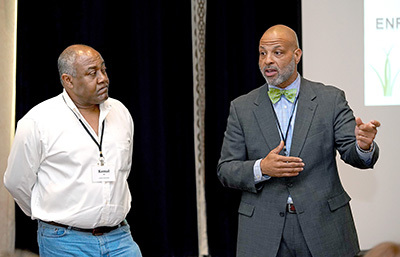
NSF INCLUDES Coordination Hub: Building a National Network to Advance Equity in STEM
Shari Gardner & Kate Goddard, SRI International
Kate Goddard and Shari Gardner, representing the NSF INCLUDES Coordination Hub, presented information about the role of the Coordination Hub in advancing the NSF INCLUDES vision to change the narrative of STEM inclusion. The coordination HUB strengthens a common vision among those working to improve equity and inclusion in STEM; brokers connections among Network members and across sectors, measures progress and impact across the Network via a shared measures system; promotes success of Network members, and elevates expertise by curating resources to support learning, action, and sustainability; and advances the field by sharing discoveries, broadening engagement, and catalyzing action that improves STEM inclusion and equity. Kate and Shari highlighted work from the NSF INCLUDES Alliances and Design and Development Launch Pilots to illustrate the growing network of partners committed to developing a more inclusive, equitable, and diverse STEM workforce, and shared opportunities for engagement with the National Network, including the website, an online community, social media, a newsletter, affinity groups, and events.
Promoting Universal Design to Create a Culture of Inclusion
Sheryl Burgstahler, University of Washington
An inclusive environment lets in everyone who meets requirements with or without accommodations and makes sure everyone feels welcome and engaged. Ability exists on a continuum, where all individuals are more or less able to see, hear, walk, read print, communicate verbally, tune out distractions, learn, or manage their health. Most disabilities are invisible and many students and staff don’t report their disabilities to disability service offices. Regardless of where a person falls on this continuum and whether they request accommodations, we want to ensure that they have access to the classes we teach and resources we share. Students’ identities are also multi-faceted, which means we must consider an intersectional approach that acknowledges that some students are from more than one underrepresented group.
How society views disability has changed throughout the years. People with disabilities historically have been eliminated or excluded from society, segregated from the general population, aimed to be cured, rehabilitated, accommodated, and finally, accepted and included as they are. The modern approach has its roots in social justice and aims to allow all people to feel included, including those with disabilities.
In K-12 education, every child is offered a free and appropriate education in as integrated setting as possible. Once students reach postsecondary education, they must meet the entrance requirements with or without reasonable accommodations. There are two approaches for making college and university campuses accessible: accommodations and universal design (UD). Accommodations are reactive and allow us to address the inaccessible features of a product or environment to make it more accessible to a particular individual who finds it inaccessible (e.g., captioning a video when a student with a hearing impairment requests it). Universal design is a proactive approach to create a product or environment accessible to the widest group possible (e.g., captioning all videos by default). A building with stairs at the entrance and a separate ramp for people with wheelchairs is technically accessible, while a building with a single entrance that everyone can use is universally designed. Universal design doesn’t just help people with disabilities—sloped entrances help people moving carts, and captions help those learning English or in noisy environments, as just a few examples. Universally designed technology should have built in accessibility features and ensure compatibility with assistive technology.
UD of instruction is an attitude that values diversity, equity, and inclusion. It can be implemented incrementally, focuses on benefits to all students, promotes good teaching practice, does not lower academic standards, and minimizes the need for accommodations. UD can be applied to all aspects of instruction, including class climate, interactions, physical environments and products, delivery methods, information resources and technology, feedback, and assessment. To review an easy to use checklist, visit Equal Access: Universal Design of Instruction. For more tips, you can follow my 20 Tips for Teaching an Accessible Online Course found online.
Why Accessible Information Technology is Critical for an Inclusive Project
Gaby de Jongh, University of Washington
Assistive technology (AT) is software, hardware, devices, or equipment that is used to increase, maintain, or improve the functional capabilities of individuals with disabilities. AT includes both devices and services. Many “high tech” and “low tech” devices are available to assist people with disabilities overcome barriers to completing daily tasks, such as reading and writing documents, communicating with others, and searching for information on the Internet.
People with mobility disabilities use a variety of technologies. Some technology assists individuals with little or no use of their hands in using a standard keyboard. Individuals who have use of one finger, or have access to a mouth- or head-stick or some other pointing device, can control the computer by pressing keys with the pointing device, and software utilities can create “sticky keys” and other options to enhance accessibility.
People who are blind or have low vision cannot access visual materials and need a system that can read text out loud or create braille with an embosser or a refreshable display. For people who are deaf or hard of hearing, captions and translators are often needed for videos or conversations. People with learning disabilities use a wide variety of technology depending on their specific disabilities; examples include software that can read text aloud or input text from speech, dictation, and alternative color options.
An example of an individual who uses multiple forms of high tech assistive devices is Stephen Hawking. He uses a combination of eye tracking, augmentative communication device, head array, and power wheelchair; check it out here. For more examples of how computer technology and AT can assist people with disabilities, read the publication Working Together: People with Disabilities and Computer Technology.
Northeastern U.S.: Best Practices in Broadening Participation
All participants: On Post-it Notes, write promising broadening participation practices that could be implemented in ERCs (pink), INCLUDES projects (blue), and in departments/institutions (yellow).
The Keys to STEM Success for Urban Youth
Alaine Allen, University of Pittsburgh
Through an NSF INCLUDES Design and Development Launch Pilot called Diversifying Access to Urban Universities for Students in STEM Fields, a team of faculty, program directors, and student researchers at the University of Pittsburgh worked collaboratively to identify how pre-college programs can more effectively prepare students to persist through college graduation as STEM majors. Through literature searches, faculty interviews and student focus groups, the team developed a list of the knowledge, skills, and habits of mind most prevalent in successful STEM majors. Critical knowledge and skills identified during the project include understanding of math, verbal and written communication skills, reading comprehension skills, critical thinking and scientific reasoning skills, awareness of STEM opportunities, and awareness of the college selection process. Important habits of mind include the ability to take risks and process failure, collaboration, curiosity, ownership of learning, persistence, understanding the relevance of STEM, responsibility, a sense of belonging or having a STEM identity, and time management. Student focus groups resulted in the following observations: connecting STEM to everyday life is important, mentoring and being mentored is of high value, a typical “STEM knowledge and skills list” can feel intimidating, and learning time management is imperative. While many students shared stories of initial struggles and many experienced challenges related to impostor syndrome, students reported they were motivated by high expectations and mentoring.
S-TEAMS Improve Sense of Inclusion for Underrepresented Groups
Amy Tuininga, Montclair State University
Studies have shown that through team activities and shared communication, students gain empathy and build trust. These collaborations help build diversity in research, which supports better critical thinking and problem-solving within STEM disciplines. The Sustainability Teams Empower and Amplify Membership in STEM (S-TEAMS) project examines alternative approaches to broadly enhancing diversity in STEM, such as methods to build a sense of community and perceived program benefits. The S-TEAMS project centers around STEM work in the field of sustainability, which allows students to deeply engage in active learning and creates a supportive environment for students from underrepresented groups to come together with expertise from multiple backgrounds and disciplines.
Each team consists of five members, each from a different discipline such as biology, chemistry, computer and information sciences, geography, geology, mathematics, physics, and sustainability science. They work together for ten weeks in the summer on real-world projects with corporations, government organizations, and nongovernment organizations. After intensive work developing project deliverables for hosting organizations, the majority of S-TEAMS participants indicated positive experiences working as part of a team with other students and overall felt part of the group. These experiences transcend disciplines and backgrounds to build pathways forward toward graduate and professional schools and careers. During the study and work, the project connected with prospective employers during interviews and placement of S-TEAM students.
University of Florida (UF) & the Consortium of Minority Doctoral Scholars (CMDS) Programs Collaborative Best Practices
Michael Smith, National Consortium for Graduate Degrees for Minorities in Engineering and Science, Inc. (GEM)
The INCLUDES Consortium of Minority Doctoral Scholars (CMDS) identifies best practices in recruiting and retaining Hispanic and African American/Black doctoral students in engineering, computing, and information sciences. CDMS focuses on the role of mentorship in pursing graduate studies in STEM fields. Drawing from a sample of students and administrators from three of the nation's largest and oldest minority doctoral scholars programs (National GEM Consortium, McKnight Doctoral Fellows, and the Southern Regional Education Board), interviews were conducted with 67 participants (17 administrators and 50 students). In an effort to broaden participation, retention, and success of underrepresented students in STEM through all levels of academia to graduate with a doctorate and to further pursue academic positions, the project focuses on qualitative data that examines in-depth experiences and perceptions of program participants as a contribution toward constructing a framework for mentoring underrepresented students in STEM fields.
The collective impact framework was at the core of the partnership formed between the University of Florida (UF) Computer and Information Science and Engineering Department, UF Graduate School Office of Graduate Minority Programs, and the UF Informatics Institute, as well as the three doctoral scholars programs, with the purpose of sharing key data and collaborating in new ways. The core best practice focuses on data sharing and a formal data sharing agreement. The keys of success of the agreements are threefold: 1) personal data management core values, 2) ensuring protection of personal data (no harm to participants rule), and 3) data sharing that builds bridges under the collective impact framework.
Expanding Diversity through the Creation of Learning Opportunities for Minority Students
Aristides Marcano, Delaware State University
The DDLP proposal Expanding Diversity in Energy and Environmental Sustainability through the creation of learning opportunities for minority students in the Mid-Atlantic region seeks to establish a network of institutions dedicated to broadening participation in the fields of renewable energy, environmental, food, and agricultural sustainability as part of an INCLUDES Alliance. Delaware State University, a historically-black university, is the leading institution of the effort. The project proposal was formed with the participation of the private sector, the local community, the Capital School District, nine universities and two laboratories within the United States Department of Agriculture (Agriculture Research Services), among other organizations.
The project will help ensure students have clear paths to job opportunities as it seeks to:
- Build a network of institutions with active collaboration in the areas of renewable energies, environmental, food, and agricultural sustainability.
- Build a pipeline for education on renewable energies and sustainability that start in local K-12 institutions, continue into the baccalaureate degree, and forward into the job market or graduate program within the network.
- Strengthen the bachelor of science (BS) degree in Green Energy Engineering and BS Degree in Renewable Energy at Delaware State University.
LiFE: Collaboration Potentials and Partnerships
James Lipuma & Cristo Leon, New Jersey Institute of Technology
The LiFE project aims to develop and strengthen STEM clubs for 3rd - 6th grade girls and incorporate leadership, collaboration and other skills through interactions with role models and through participation in various support activities and auxiliary events.
The project vision is to demonstrate the small-scale success of existing work and develop a customizable playbook that can be used to replicate the project across the country. Over the longer term, we hope LiFE will grow to become a “cradle to career” project with a network of women at all stages of education and career mentoring and being mentored by near-peers toward success in STEAM pursuits. Thus, the project will gather partners to create an alliance and pursue funding opportunities (including to become a backbone of an NSF INCLUDES Alliance) that will enable the program to expand nationally.
Southeastern U.S.: Best Practices in Broadening Participation
All participants: On Post-it Notes, write promising broadening participation practices that could be implemented in ERCs, INCLUDES projects, and/or in departments/institutions.
An Integrated Approach to Retain Underrepresented Minority Students in STEM Disciplines
Sarwan Dhir, Fort Valley State University
The long-term goal of the proposed project is to enhance recruitment, retention, productivity, and satisfaction of underrepresented minority (URM) students who enroll in STEM graduate programs, particularly at primarily white/research-intensive (PWI/RI) institutions that award most of the PhDs in STEM. The immediate goals are two-fold: (a) to empower URM students to more effectively navigate STEM undergraduate and graduate programs at minority-serving (MSI) and PWI/RI institutions and (b) to effect a collaborative transformation of the culture at PWI/RI institutions and better support URM students in STEM graduate programs.
The collaborating universities will work together for the purposes of empowering URM students to more effectively navigate STEM undergraduate and graduate education at MSIs and PWIs, as well as for transforming the culture of PWIs and RIs. The team plans to use evidence-based approaches to gain insights into cultural differences that impact the success of URM STEM students. The pilot study will facilitate undergraduate URM student exchanges between MSIs and PWIs; collaborative inquiry to engage URM students in social science research about issues and experiences of under-representation in STEM; and the adaptation of resources from the Center for the Integration of Research, Teaching and Learning (CIRTL) to train STEM faculty to embrace diversity and improve teaching in diverse classroom settings. The project seeks to answer the following questions:
- Can an academic year “exchange program” be designed to enhance underrepresented students’ cultural competence and thereby academic success in STEM disciplines?
- Can underrepresented students’ experiences at PWI/RI and MSI institutions be mined to identify aspects of institutional culture that enhance or limit their success in STEM disciplines? learning-through-diversity and offer more inclusive instruction?
- Can underrepresented students’ experiences at PWI/RI and MSI institutions be harnessed to train STEM educators to value?
Early STEM Engagement for Minority Males
Kamal Ali, Jackson State University; and Derrick Gilmore, Kentucky State University
Select minority-serving institutions are partnering together to increase the number of minority males in STEM through an INCLUDES DDLP project called Early STEM Engagement for Minority Males (eSEM). The project hosted a workshop and developed a driver diagram in 2017, launched three Network Improvement Community (NIC) workgroups in 2018, and implemented NIC Plan-Do-Study-Act cycles starting in 2018.
The project serves middle school students, who are young enough to feel the best effects and growth of interest. Middle school student participants are offered an intensive summer STEM-based course for 2 to 4 weeks, as well as a monthly one-day program during the Fall and Spring semesters. The project draws its focus from efforts at Kentucky State University and Jackson State University.
Concurrent Enrollment Partnerships: Broadening Participation In STEM Education in Rural Georgia
Shawn Utley, Wiregrass Georgia Technical College
The Wiregrass Georgia Technical College’s (WGTC’s) NSF Georgia Science, Technology and Engineering Partners for Success (STEPS) project continues to grow beyond its original intent and projections. In an effort to recruit and support diverse individuals in STEM education opportunities, WGTC aggressively pursued Concurrent Enrollment opportunities throughout its 11 county service area. While serving 28 high schools in rural south Georgia, WGTC identified early on that they possessed the resources to address the multiple NSF broadening participation challenges posted in 2008, which include need for increased number of underrepresented students involved in STEM; more inclusion of community college in NSF funding; enhancing the infrastructure for research at community colleges; and geographic expansion of NSF funding to rural Institutes of Higher Learning (IHE).
Concurrent enrollment was identified as the critical vessel in offering college-level STEM instruction to high school students located in geographically, economically, and access challenged schools. These opportunities prepare students for university enrollment as they learn about the design, development, and integration of robotics; applying automation technologies to a real world work problem; and using analytical skills.
Interdisciplinary Research Between Social Science and Engineering
Chien-fei Chen, CURENT, University of Tennessee
Informing engineers of social science research can allow them to pay more attention to issues that might be related to equity. Interdisciplinary research between social science and engineering brings many benefits, particularly added creativity and learning opportunities. Such research is especially important because different minds can come together to solve critical problems, as well as critically evaluate the data and knowledge coming together. However, there are many challenges to such integration. It can be difficult for people from different academic backgrounds to communicate, manage similar timelines and commitments, and/or find who falls into what roll of a project. It can often be timely and expensive for social scientists to meet computer scientists or engineers and work on the issues.
Central U.S. & Louisiana: Best Practices in Broadening Participation
Theoretical Frameworks: So What Are They Good For, Anyway?
Sylvia Mendez, University of Colorado Colorado Springs
Theoretical frameworks provide a lens through which individuals approach research questions philosophically, analytically, and methodologically. Theories are a set of interrelated constructs, definitions, and propositions that present a systematic view of a phenomena by specifying relationships among variables with the purpose of explaining, predicting, and understanding said phenomenon. A good theory is created when it can:
- Provide a simple explanation of the observed relations relevant to a phenomenon
- Be consistent with both the observed relations and an already established body of knowledge
- Be considered a tentative explanation and should provide means for verification and revision
- Stimulate further research in areas that need investigation
Theoretical frameworks provide a structure to hold and support a theory in the context of a research project. Identifying an optimal theoretical framework can be achieved by being well-read in the field of social science, and discussing various frameworks with colleagues. A framework plays a key role in understanding almost every aspect of a study—it helps one make reasoned decisions throughout a research endeavor. They focus a study, reveal and conceal meaning and understanding, situate the research, and reveal strengths and weaknesses.
Applying Systems Thinking to Broadening Participation
Liz Lehman, University of Chicago
Project Systems-Thinking Approach to STEM Ecosystem Development In Chicago (SYSTEMIC) is an NSF INCLUDES DDLP that aims to increase the participation of black youth in Chicago's Austin neighborhood in STEM programming. Project SYSTEMIC is unique in its application of systems thinking methodology to tackle this complex problem: avoid a top-down approach, build from the ground-up to wrestle with systemic challenges alongside community members, and think about Austin as an existing STEM learning ecosystem, with diverse assets and complex relationships.
Project SYSTEMIC is about supporting the community to map the existing ecosystem, navigate it, and design localized strategies to broaden participation. Systems thinking allows the project team to tackle complex problems by focusing on the interactions and interdependencies of elements of the systems. This approach has identified community stakeholders by working with local leadership, engaging those groups in systems thinking methods to map the current STEM learning ecosystem in the Austin neighborhood, and supporting the community to use their map to discuss changes.
Including Families of URMs in the SEAS Your Tomorrow INCLUDES Program
Nastassia Jones, Southern University and A&M College
The Supporting Emerging Aquatic Scientists (SEAS) Your Tomorrow program is a collaborative proposal between the University of the Virgin Islands, Pennsylvania State University, and Southern Utah University that focuses on building scientific identity to increase interest and engagement in STEM, particularly marine sciences, among students in the U.S. Virgin Islands. The program includes three targeted intervention points: (1) field experiences in the marine sciences for middle and high school students, (2) early field research experiences for college freshmen and sophomore students, and (3) bridge to the PhD style programming for graduate students. This program also highlights intervention support programming across all intervention points, including tiered mentoring and mentor training for partners and participants, individualized development plans, and family programming to support student success.
Because of the importance of family, the project invites families to be a part of activities via videoconference sessions both at the beginning and end of the project. The goals of the family programming events are to explain the overall focus of the program, expose family members to the continuing education and career opportunities available through scientific research, allow family members to hear the overall account of their participant’s learning outcomes and experiences through the project, and outline a potential pathway for their participant to progress from undergraduate to graduate to career. Initial observations from this project include positive feedback and new revelations from family members, who are empowered to better support their student in progressing towards career goals.
Utilizing Partnerships to Address Challenges in STEM Career Education
Kelly Johanson, Xavier University
Xavier University of Louisiana is a historically Black and Catholic university known for its success in preparing students for medical and pharmacy school. Hundreds of new science students, predominantly from groups underrepresented in STEM, make up the freshman class each year with most citing Xavier’s strong pre-medicine and pre-pharmacy programs as their reason for attending. Over half of the pre-medicine or pre-pharmacy students either change their major or do not pursue their original career goal for a number of different reasons. Unfortunately many who fall into this category do not pursue a career in STEM, often due to a lack of knowledge about the different career options available outside of medicine or lack of preparation for graduate school.
A major initiative of the Xavier National Institutes of Health (NIH) National Institute of General Medical Sciences (NIGMS) Building Infrastructure through Diversity (BUILD) program at Xavier is focused on developing effective ways to educate these science-minded students about the different types of careers available after obtaining a STEM Ph.D. Partnerships with research-intensive universities through both BUILD and NSF Broadening Experience in Scientific Training – Beginning Enhancement Track (BEST-BET) programs have allowed the team to pilot two different STEM career education activities designed to address challenges faced in encouraging our students to pursue a Ph.D. Students participating in these activities report an increased awareness of career options, more clarity with regard to their career goals, and a better understanding of what the graduate school experience is like. These activities can be adapted for use with undergraduates at both public and private universities to address similar challenges.
Western U.S.: Best Practices in Broadening Participation
Biosphere 2 Earth Systems Science for Diverse Research Experiences
Kevin Bonine, University of Arizona
Biosphere 2 is a large-scale research and education facility at the University of Arizona well suited for Earth systems science that is only possible because of the scale, control, and measurement capabilities of the 3-acre enclosed structure. Key research questions have included ocean and rainforest responses to elevated carbon dioxide, precipitation drivers of nascent soil formation, and the effects of temperature on plant physiology and microbiome variation. The Landscape Evolution Observatory (LEO) is the flagship research project at present, with expanding research on tropical soils, ocean corals, and food production systems.
Also on site is a residential casita village with 100 sleeping rooms and conference facilities. This capacity—along with the active science program, exploration by 100,000 annual visitors (10,000 being K-12 students) and university student training—makes Biosphere 2 a vibrant, multi-dimensional science hub. NSF has funded a decade of summer Research Experiences for Undergraduates (REUs) with students living at Biosphere 2 for ten weeks. Efforts to increase the diversity of participating students have paid off, with emphasis on Indigenous students. With each cohort, the team invests time and energy into building a cohesive cohort wherein diversity is valued and celebrated, and students feel empowered to support and rely upon each other while at Biosphere 2.
Because of the demographic composition of the REU cohorts, the team applied to be an INCLUDES Pilot program with collaborators at the University Corporation for Atmospheric Research (UCAR) in Boulder, CO in an attempt to provide multiple years of research and mentoring support for Indigenous students. Other elements of the INCLUDES Pilot focus on connecting to communities and youth through shared development of earth systems research projects.
Letting Students Lead the Way to Inclusive Excellence
Pam McLeod, Stanford University
Re-Inventing the Nation's Urban Water Infrastructure (ReNUWIt) is an interdisciplinary, multi-institution engineering research center focused on ways to manage urban water systems. Over the past three years, ReNUWIt has increased efforts to accelerate diversity, equity, and inclusion (DEI) within the center. ReNUWIt aims to build an inclusive climate, recruit a more diverse population of students and researchers, and expand pipeline efforts.
ReNUWIt’s unique DEI organizational structure has resulted in student-led change. For example, center leaders have facilitated high student leadership within DEI, and very successful initiatives focused on graduate admissions reform and shared tools for inclusive excellence.
Science Across Cultures: Neuroscience for Tibetan Buddhist Monastics
Eric Chudler, University of Washington
The Science for Monks program was established in 2001 to bring western scientists to India to conduct workshops to share concepts about western science with Tibetan monastics in exile. The Education Director at the Center for Neurotechnology, an ERC at the University of Washington, has participated in the program for 7 years. Benefits to western scientists include the reflection on one’s own teaching practices, discovery of the limits of specific methodology and an understanding of possible new ways to acquire knowledge.
Traditional monastic education involves years of philosophical training including logic, debate, and contemplative practices. Neuroscience has been a featured topic within the workshops by combining didactic teaching with hands-on demonstrations, experiments and scientific inquiry. The language barrier between western scientists and the monastics has been overcome by using English-Tibetan translators who often help create Tibetan words for neuroscientific concepts that do not have suitable translations. Engaging with monastic scholars who come from different cultures, speak a different language and are new to science presents exciting challenges and opportunities. Developers of engineering programs and instructors should consider these characteristics of their students to ensure that course materials are developed with appropriate language and attention to differences in learning abilities.
Engaging Individuals with Disabilities at an Engineering Research Center
Scott Bellman, University of Washington
Promising practices of the Center for Neurotechnology, an ERC at the University of Washington (UW) engage people with disabilities in all aspects of the Center. Further details are available online in a publication called Promising Practices That Engage People with Disabilities in the CNT. The strategies were presented in five broad categories:
- Recruitment and Engagement
- Develop strategic partnerships, including those with disability and veteran service units, and employ joint recruitment strategies.
- Recruit people with disabilities, including veterans, onto advisory boards and leadership teams.
- Develop outreach activities and programs especially for students with disabilities, including veterans, and also recruit individuals with disabilities into programs for all students.
- Communication
- Promote disability awareness.
- Highlight the achievements of people with disabilities.
- Include images of people with disabilities and information on how to request accommodations in promotional materials.
- Encourage faculty, staff, and student leaders to engage in disability-related conferences and training opportunities.
- Share disability-related practices at conferences.
- Accessibility of Facilities, Information Resources, Products, and Activities
- Apply universal design and provide reasonable accommodations.
- Consult with individuals with disabilities in design of labs and facilities.
- Conduct website, document, and video accessibility reviews and remediate.
- An Inclusive Climate
- Consider disability as a diversity issue.
- Provide mentoring opportunities for individuals with disabilities.
- Address disability-related issues in grant proposals to enhance and expand ERC initiatives.
- Data Collection and Evaluation
- Collect disability status along with other demographic information in application and evaluation forms.
- Analyze data to determine the effectiveness of activities for people with disabilities.
Discussion Summaries
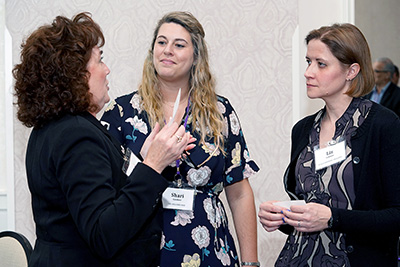
What new barriers and challenges have you uncovered as you increasingly engage individuals with diverse characteristics? How can future projects, initiatives, or collaborations address these challenges?
The following challenges were identified by CBI participants:
- Many projects that are working to increase diversity exclude sub groups and end up only focusing on one small piece of diversity or ignoring intersectionality.
- There isn’t enough data on many minority groups.
- Many of the key stakeholders who have the potential to make an impact are from STEM backgrounds, but don’t have social science backgrounds.
- Many programs don’t have open admission.
- Often times, higher education administration does not understand the importance of broadening participation programs and clear goals related to inclusion.
- Partners need more training on how to accept and advocate for all groups served.
- We must ask ourselves how we can find the best way to connect with and engage different groups, audiences, and stakeholders.
- Many people feel like they cannot disclose their disabilities, or other diverse characteristics/identities, due to lack of acceptance.
- At times, campus leaders only acknowledge the importance of mentoring in terms of time and effort.
- Underrepresented students may feel “forced” to voice their own opinions rather than feeling comfortable and voicing it when they are ready.
- There is a need for more education on microaggressions for educators and mentors.
- Mentors and educators don’t always know how to communicate with people from different backgrounds or from different minority groups.
- Some educators or leaders don’t always see the value in diversity or use a “bootstraps” approach.
- Lack of funding opportunities limit the number of opportunities and programs.
Addressing the challenges:
- The funding agencies should provide more guidance to university administrators to promote the importance of these programs.
- Faculty and student mentors need training on how to secure diverse groups and how to be more welcoming when those groups arrive.
- New practices and policies should be enacted to help students comfortably disclose their diverse characteristics and identities.
- Everyone has implicit biases. More faculty need training on this subject.
- Schools should collaborate with organizations that help expand knowledge in universal design.
- Each organization or institution should have more self-awareness on their own downsides and struggles.
- Look for what has worked, what has been proven successful, and replicate or expand on those activities and initiatives.
What resources would be useful to the ERC and INCLUDES communities to help them improve recruitment, reporting, and activities with respect to broadening participation issues?
- Sharing Metadata collections, metrics, and resources.
- Engaging with non-profit groups in STEM.
- Connecting with external evaluators for formative and summative evaluation to strengthen proposals and awards.
- Connecting with proposal writers.
- Collaborating on writing white papers.
- Creating tools to avoid addressing and/or defining underrepresented groups from a deficit framework.
- Using programs similar to Research Experiences for Undergraduates (REUs) so that people working with underrepresented groups have more access to STEM.
- Using more languages within programs for those who don’t primarily use English.
- Creating a national research mentoring network.
- Promoting outreach that links ERCs with INCLUDES work.
- Developing tools and tips for writing INCLUDES proposals.
- Sharing common activities and strategies between ERC and INCLUDES projects.
- Making an active effort in creating a more inclusive environment.
- Sharing information on network expertise and partners/programs in a database.
What best practices exist for improving the ability of educators and stakeholders to comfortably talk about race, ethnicity, gender, disability, and other diverse characteristics? How can ERC-INCLUDES help disseminate these materials broadly within ERCs and INCLUDES initiatives?
- Creating top level material and sharing it freely.
- Sharing high quality, captioned videos.
- Exploring different identities and sharing resources.
- Taking an appreciative inquiry approach.
- Hosting implicit bias training.
- Teaching tolerance at a younger age (K-12).
- Training growth mindset for faculty and others.
- Offering a platform that allows people to create a safe environment.
- Culminating a formal and supportive staff to provide resources.
- Reading Our Separate Ways: Black and White Women and the Struggle for Professional Identity by Ella L J Bell Smith, Ella L. J. Edmondson Bell, and Stella M. Nkomo.
- For ERCs, offering seminars that educate members on inclusion and diversity and creating special events that promote minority students and faculty culture.
- Creating interactive theater (e.g. Cornell Interactive Theater Ensemble or Carnegie Mellon online version).
- Offering sensitivity training within research teams in the interest of optimal productivity.
Shared Promising Practices
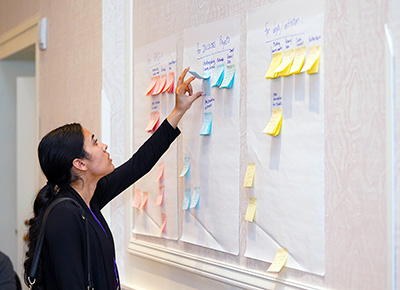
All participants shared promising broadening participation practices that could be implemented in ERCs, INCLUDES projects, and in institutions of higher education. Below, practices that could be implemented in these settings are grouped thematically.
Research and Impact
- Develop a theoretical framework for diversity and inclusion programs.
- Capitalize on existing models when developing your own programs.
- Create a system map of your diversity and inclusion programs. A system map is a visual description of the service technical organization: the different actors involved, their mutual links and the flows of materials, energy, information and resources throughout the system.
- Collect data on broadening participation programs and highlight the impact. In particular, consider longitudinal data collection that could demonstrate impact on STEM education and the workforce.
- Integrate STEM efficacy into evaluation activities.
- Collaborate with other projects and programs for collective impact. For example, the AccessERC Collaborative Recruitment Initiative promotes summer research opportunities at all ERCs to individuals with disabilities.
- Include broadening participation in your research agenda.
- Incorporate climate surveys into existing evaluation efforts.
- Consider ways that cohort building can affect sense of belonging.
- Develop a shared language with STEM scholars and professionals.
- Develop data sharing agreements and strategies.
- Increase the number of workshops and INCLUDES conferences regarding collective impact, including the role of backbones, hubs, and participants.
Partnerships
- Improve REU recruitment through engagement with conferences like those of the American Indian Science and Engineering Society (AISES) and Society for Advancement of Chicanos/Hispanics & Native Americans in Science (SACNAS), and through state-level indigenous groups. Leverage connections while at meetings, bring students to these meetings, and engage consistently over time.
- Connect with NSF-funded INCLUDES, Organizational Change for Gender Equity in STEM Academic Professions (ADVANCE), and Advancing Informal STEM Learning (AISL) projects or other broadening participation projects on your campus.
- Develop a comprehensive list of potential stakeholders including individuals in community colleges, Historically Black Colleges and Universities (HBCUs) and other minority serving institutions, non-profits, and industry.
- Seek out the expertise of existing communities, programs and individuals that work with underrepresented populations. Leverage partnerships with existing, successful programs rather than developing your own programs from the ground up.
- Online meetings can allow you to engage with a wider set of stakeholders as compared to meeting solely in person.
- Consider student and faculty exchange programs with minority serving institutions for cultural competency development.
- Connect 2-year colleges to 4-year institutions for faculty development, and promote job opportunities at community colleges for graduate students.
- Partner with STEM education programs to evaluate their impact.
- Engage companies in your efforts and offer them many different types of opportunities for engagement with your students and activities.
- Develop communities of practice among your leadership to advance inclusive practices.
Mentoring, advising, coaching, and role models
- Organize career panels for students from underrepresented groups, where students speak to faculty, staff, and other stakeholders about their experiences on campus.
- Plan programming for families as a way to support first generation college students, especially within communities where family involvement is a strong cultural norm. Encourage students to invite a family member and bring them to an event.
- Conduct assessments and evaluations of mentoring activities.
- Find role models for students in novel ways (e.g., leveraging social media). Encourage students to follow powerful role models on social media. An interesting social media relation gives students common ground and feelings of inclusion, in addition to inspiration in their field.
- Differentiate between advisors and mentors, and be sure students understand the roles and potential impact of all individuals available for support.
- Be mindful of the need for culturally representative mentoring for everyone (e.g., minority males in engineering).
- Have undergraduates shadow graduate students to better understand what graduate student life is like.
- Engage in community outreach where postsecondary students serve as role models to their communities.
- Hold listening sessions with communities that you work with in order to learn from them.
Dissemination, Promotion, and Marketing
- Make websites, PDFs, and videos accessible to everyone. For example, caption videos, follow WCAG 2.0 guidelines for websites, and markup PDF files.
- Create a unified and shared platform or folder to share information with the entire community.
- Carefully consider strategies for publicizing your successes. Consider your target audience for each action, and be sure to speak to their interests and needs.
- Use an asset-based approach to community engagement.
Team building, training, and capacity building
- Create a diversity and inclusion advisory board.
- Incorporate mentoring and coaching strategies into faculty professional development.
- Offer IT accessibility presentations to all faculty, staff & students and evaluate your website for accessibility.
- Utilize emeriti faculty as mentors.
- Ask leaders and faculty from underrepresented groups about their input around being a figurehead and managing minority initiatives. Consider whether the same people are repeatedly asked to get involved because of their identity.
- Increase educators’ awareness of practices that support minority male success in STEM.
- Connect with the National Alliance for Inclusive & Diverse STEM Faculty (ASPIRE) to help develop inclusive faculty practice that addresses disability.
- Make connections to civil and social justice research projects.
- Consider diverse socio-economic perspectives.
- Find dynamic guest speakers or use TED-style presentations.
- Explore corporate funding for staff support.
Other interventions for students
- Provide leadership opportunities for students.
- Conduct listening sessions to hear directly from engineering students.
- Provide professional development workshops to students. Topics could include confidence, leadership, grant-writing, and public speaking.
- Hold all students to high expectations.
- Volunteer together as a team-building strategy.
- Understand the cultural needs of your students and acknowledge that there are different ways of knowing.
- Reflect on ways that men can serve as allies to women in STEM.
- Encourage a growth mindset as a cultural norm within your project/institution.
- Leverage students’ altruistic motivations (social justice, improve humanity) to encourage STEM participation. Topics that bring a human impact aspect to engineering may attract diverse students.
- Connect STEM to everyday experiences and encourage students to learn about a variety of STEM fields.
- Consider ways to make REUs more accessible to wide groups of students – including students with families, students with disabilities, and students from varied cultural backgrounds.
- Review program admission policies and how they might affect diverse populations (e.g., discriminatory screening algorithms, majority-dominated selection committees).
Action Planning Summaries
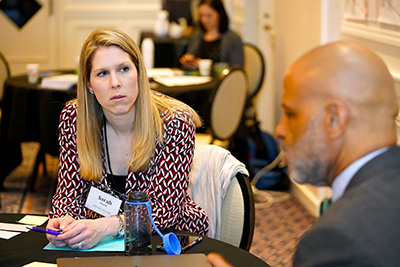
CBI participants were presented the following question: What actions will you take in your project or at your institution given what you gained from this CBI? Their responses included the following:
- “This even gave me the opportunity to gain connections and start important conversations--I'd like to plan on extending those conversations and continuing to build our community and support systems. I'd also like to learn more about ERCS.”
- “We'd like to continue the discussion around accessibility and present on the subject to our Dean and colleagues. Then we can move forward with creating accessible materials and universally designed webpages.”
- “I want to coordinate with the disabilities office to ensure that my work spaces and labs are ready for all students. Ensure that our admissions process is accessible and inclusive for all.”
- “ Let us convene all colleagues at the University of Arizona to learn all the elements of successful ERCs and consider an ERC proposal. We will also explore the bios and projects of workshop participants in hopes of getting new ideas and finding potential collaborators, and share these ideas and diversity information with those within our program and school.”
- “Our team will work on digital accessibility, reviewing our website and captioning our videos. We also plan on connecting with people who could work with us on virtual tools for promoting inclusion and mentoring, including finishing the toolkit I am in the process of making.”
- “Our team is trying to incorporate universal design into all of our projects, as well as add videos from this conference onto our website. I want a diversity statement that includes requests for accommodations and to include people from diverse backgrounds into all of our work.”
- “My ERC student leadership council will be creating a training program for new students joining the ERC. Much of the information here will be useful as I help design the diversity and inclusion modules for this training- particularly the aspects of inclusion tip sheets presented. I also recognized challenges of mentoring compared to advising that are prevalent in my ERC.”
- “I am going to use the checklists to help prepare our graduate students and faculty for our summer programs, as well as review our websites and policies for accessibility. I also hope to collaborate with others on how to create a more inclusive environment and use universal design.”
- “I want to implement a mentorship program, follow more inclusive practices, collaborate with other INCLUDES projects, and share our inclusive strategic plan.”
- “We will review our diversity and inclusion policies and practices and create focus groups to discuss and create best practices.”
- “We will identify new resources and collaborate with others on inclusion.”
- “I will give explicit attention to accessibility in communications in various forms and consider how to make existing networks more visible or known to more broad audiences who could benefit from them. I also plan to observe ERC list to determine sites that connect to our INCLUDES work, be intentional about engaging families and communities in our work. Finally, I will look for ways to engage faculty in work to broaden participation, which will in turn develop allies and incorporate universal design into work and general education practices.”
- “I am in a course building phase in my new faculty position, so I will create accessible documents using the tips presented at the CBI. Our program/department is also in a rebuilding/branding phase so this information is timely in improving our program. I’m most excited about collaborations! I will follow-up with specific people/projects as it relates to teacher training opportunities and engineering education work.”
- “I plan on making our project more inclusive, creating more accessible websites/documents, and engaging with student families.”
- “I will share DO-IT’s videos and resources with my colleagues.”
- “I am going to work on developing an alumni network of PhDs to help with career exploration activities.”
- “I will work on student-led diversity initiatives and will use AccessERC to evaluate our new Precise Advanced Technologies and Health Systems for Underserved Populations (PATHS-UP) newsletter and website for accessibility compliances. Also, I will add AccessERC videos to PATHS-UP website and plan to review the mentoring resources mentioned here. This conference also gave me the opportunity to work with Sylvia Mendez on their program and work with Pam McLeod on inclusive resources.”
- “I want to work on making our own materials more accessible and share materials with others at my institution. I also plan to circle back with Scott and Sheryl on a couple of items where my experiences could benefit from additional insights and where they contradict materials presented. I will also work on planning cross-program interactions between students and improving inclusion of students from institutions in our program.”
- “I will examine my research labs for accessibility and add questions about special needs in the application to join my research group. Also, I will ask my students to identify, or draw my attention to anything that can make my class more accessible. Finally, I will try to be more affective/sensitive to others.”
CBI Participants
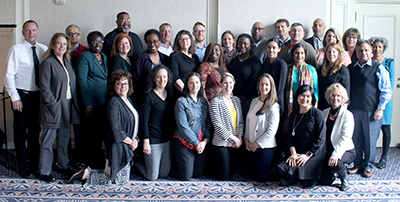
Adrian Thomas
Diversity and Inclusion Director
ERC: Center for Innovative and Strategic Transformation of Alkane Resources
Purdue University
atthomas@purdue.edu
Alaine Allen
INCLUDES: Diversifying Access in STEM
Director, K-12 Outreach and Community Engagement
University of Pittsburgh
allen@pitt.edu
Amy Tuininga
Director, PSEG Institute for Sustainability Studies
INCLUDES: Sustainability Teams Empower and Amplify Membership in STEM
Montclair State University
tuiningaa@montclair.edu
Aristides Marcano
Research Professor
INCLUDES: Expanding Diversity in Energy and Environmental Sustainability through the Creation of Learning Opportunities for Minority Students in the Mid-Atlantic Region
Delaware State University
amarcano@desu.edu
Brianna Blaser
Program Coordinator
ERC-INCLUDES
University of Washington
blaser@uw.edu
Chien-fei Chen
Director of Education and Diversity & Research Associate Professor
ERC: Center for Ultra-Wide-Area Resilient Electric Energy Transmission Networks
University of Tennessee Knoxville
cchen26@utk.edu
Cristo Leon
Director of Research CSLA at NJIT
INCLUDES: Leadership and iSTEAM for Females in Elementary School: An Integrated Approach to Increase the Number of Women Pursuing Careers in STEM
New Jersey Institute of Technology
leonc@njit.edu
Derrick Gilmore
Deputy Provost
INCLUDES: Early STEM Engagement for Minority Males
Kentucky State University
derrick.gilmore@kysu.edu
Dhir Sarwan
Professor
INCLUDES: An Integrated Approach to Retain Underrepresented Minority Students in STEM Disciplines
Fort Valley State University
dhirs0@fvsu.edu
Eric Chudler
Executive Director and Education Director
ERC: Center for Neurotechnology
University of Washington
chudler@uw.edu
James Lipuma
Director of CLEAR
INCLUDES: Leadership and iSTEAM for Females in Elementary School: An Integrated Approach to Increase the Number of Women Pursuing Careers in STEM
New Jersey Institute of Technology
lipuma@njit.edu
Janis Wignall
PreCollege Education Manager
ERC: Center for Neurotechnology
University of Washington
wignall@uw.edu
Jayadev S Athreya
Associate Professor of Mathematics
INCLUDES: Indigenous Math Circles Communities
jathreya@uw.edu
Kamal Ali
eSEM Instructor
INCLUDES: Early STEM Engagement for Minority Males
Jackson State University
kamal.ali@jsums.edu
Kate Goddard
Project Director
NSF INCLUDES
kgoddard@edc.org
Kelly Johanson
Associate Professor
INCLUDES: Broadening Experiences in Scientific Training - Beginning Enhancement Track
Xavier University of Louisiana
kjohanso@xula.edu
Keshia Ashe
American Association for the Advancement of Science (AAAS) Fellow
National Science Foundation
kashe@nsf.gov
Kevin Bonine
Director of Education & Outreach
INCLUDES: Integrating Indigenous and Western Knowledge to Transform Learning and Discovery in the Geosciences
University of Arizona
kebonine@email.arizona.edu
Krishna Athreya
Inclusion and Diversity Consultant
ERC: Center for Biorenewable Chemicals (graduated Center)
Iowa State University
ksathreya@gmail.com
Kristen Bergsman
Engineering Education Research Manager
ERC: Center for Neurotechnology
University of Washington
Bergsman@uw.edu
Linda Hyman
Associate Provost, School of Medicine
INCLUDES: Broadening Experiences in Scientific Training - Beginning Enhancement Track
Boston University
lhyman@bu.edu
Liz Lehman
School Development Manager
INCLUDES: A Systems-Thinking Approach to STEM Ecosystem Development in Chicago
University of Chicago
emlehman@uchicago.edu
Maeve Drummond
Assistant Director, Education
ERC for Innovative and Strategic Transformation of Alkane Resources
Purdue University
maeve@purdue.edu
Michael Edgar
Graduate Student
ERC: Center for Bio-Mediated and Bio-Inspired Geotechnics
Arizona State University
mgedgar@asu.edu
Michael Smith
Deputy Executive Director
INCLUDES: Consortium of Minority Doctoral Scholars Programs in Computer Science & Engineering
GEM Fellowship
msmith@gemfellowship.org
Nastassia N. Jones
Associate Professor
INCLUDES: Consortium of Minority Doctoral Scholars Programs in Computer Science & Engineering
Southern University
nastassia_jones@subr.edu
Pam McLeod
Education and Outreach Director
Diversity and Inclusion Manager
ERC: Reinventing the Nation's Urban Water Infrastructure
Stanford University
pamelamc@stanford.edu
Roy Charles
Diversity Director
ERC for Future Renewable Energy Delivery and Management
Nanosystems ERC for Advanced Self-Powered Systems of Integrated Sensors and Technology
North Carolina State University
racharl2@ncsu.edu
Sarah Rozelle
Assistant Teaching Professor
INCLUDES: Broadening Experiences in Scientific Training, Beginning Enhancement Track
University of Massachusetts Lowell
sarah_rozelle@uml.edu
Scott Bellman
Associate Director of Diversity, Center for Neurotechnology
Program Manager, Disabilities, Opportunities, Internetworking, and Technology (DO-IT)
Project Director, ERC-INCLUDES
Swb3@uw.edu
Shari Gardner
Education Researcher
SRI International
shari.gardner@sri.com
Shawn Utley
Dr. Shawn Utley, Executive VP Academic Affairs
INCLUDES: Georgia STEPS (Science, Technology and Engineering Partners for Success)
Wiregrass Georgia Technical College
shawn.utley@wiregrass.edu
Sheryl Burgstahler
Co-Director of Diversity, Center for Neurotechnology
Director, Disabilities, Opportunities, Internetworking, and Technology (DO-IT)
PI, ERC-INCLUDES
sherylb@uw.edu
Sylvia Mendez
Associate Professor
INCLUDES: Increasing Minority Presence within Academia through Continuous Training
University of Colorado Colorado Springs
smendez@uccs.edu
Teri Reed
Assistant Vice President, Office of Research
University of Cincinnati
teri.reed@uc.edu
Theresa Chatman
Diversity Director
Precise Advanced Technologies and Health Systems for Underserved Populations ERC
Rice University
tlc@rice.edu
Tonya Peeples
Penn State College of Engineering Associate Dean for Equity and Inclusion
INCLUDES: Aspire Alliance
Penn State
tzp225@psu.edu
Yolanda Rangel
LEAP Coordinator
INCLUDES: Nevada Learn and Earn Advanced-career Pathway Project (LEAP)
University of Nevada Reno
rangely@unr.edu
Communities of Practice (CoP)
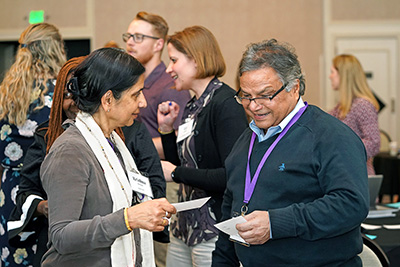
CBI participants are welcomed into two CoPs:
ERC INCLUDES CoP
ERC INCLUDES - This affinity group brings together individuals from NSF-funded Engineering Research Centers (ERCs) and individuals who work to lead and support NSF-funded INCLUDES initiatives. Members will share best practices that create a robust culture of inclusion and diversity in both programs. The group will address ways to make activities and resources accessible and inclusive; develop collaborations; collect and report data on diversity; and include people with diverse characteristics in leadership roles, research, and activities.
Individuals can join the ERC INCLUDES CoP by joining the NSF INCLUDES National Network.
AccessERC CoP
Populated with individuals who work at NSF-funded ERCs across the United States, members of the AccessERC Community of Practice (CoP)
- discuss how to recruit participants with disabilities and accommodate them in their programs and activities;
- recruit their student participants with disabilities into disability-related e-mentoring, internships, and workshops to complement their activities;
- discuss the implementation of universal design to make facilities, products, and activities more welcoming and accessible to individuals with disabilities;
- discuss best practices and resources identified at capacity-building institutes; and
- share ideas about seed grants, new initiatives, and lessons learned.
Individuals can join the AccessERC CoP by contacting doit@uw.edu.
For information about other CoPs hosted by DO-IT, consult Communities of Practice on the DO-IT website.
Resources for Increasing Accessibility and Supporting Individuals with Disabilities
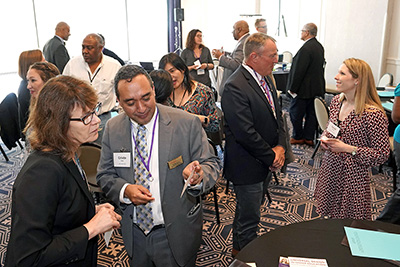
ERC-INCLUDES partners with AccessERC to maintain a searchable database of frequently asked questions, case studies, and promising practices related to how educators and employers can fully include students with disabilities. The Knowledge Base is an excellent resource for ideas that can be implemented in programs in order to better serve students with disabilities. In particular, the promising practices articles serve to spread the word about practices that show evidence of improving the participation of people with disabilities in postsecondary education.
Examples of Knowledge Base questions include the following:
- Are electronic whiteboards accessible to people with disabilities?
- Are peer review tools accessible?
- Are there computer keyboards designed to be used with only one hand?
- Are touch screens accessible?
- Do postsecondary institutions have to provide assistive technology (for example, screen enlargement or voice recognition software) to students with disabilities who enroll in distance learning courses?
- Does a postsecondary institution have to provide specific hardware or software (known as assistive technology) that an individual with a disability requests so that they can access information technology used on campus?
- Are funds available specifically for captioning?
- Are there any web-based tutorials on web accessibility?
Individuals and organizations are encouraged to propose questions and answers, case studies, and promising practices for the Knowledge Base. Contributions and suggestions can be sent to doit@uw.edu.
For more information on making your campus technology accessible and to learn more about accessible learning or universal design, review the following websites and brochures:
- The University of Washington’s hub for information on accessible technology, featuring how to create and develop accessible documents, videos, and websites, can be found here.
- Accessible University’s website featuring common web accessibility principles and solutions can be found here.
- A brochure on universally designing distance learning programs can be found on Equal Access: Universal Design of Distance Learning Programs.
- A brochure on what accessible distance learning is and how it helps students can be found on Accessible Distance Learning.
- A brochure on why accessible web design matters, and some resources to make your website accessible, can be found on Accessible Web Design.
More information on universal design in education can be found at the Center for Universal Design in Education.
More information and resources for engineering research center accessibility practices can be found at the AccessERC website. Furthermore, information and resources for engineering education can be found at the AccessEngineering website.
Acknowledgments
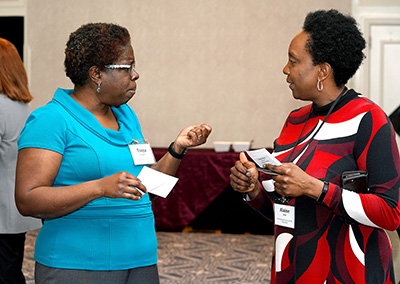
ERC-INCLUDES capacity building activities are funded by the National Science Foundation under Grant #EEC-1028725. Any opinions, findings, and conclusions or recommendations expressed in this material are those of the CBI presenters, attendees, and publication authors and do not necessarily reflect the views of the National Science Foundation or University of Washington.
DO-IT
University of Washington
Box 354842
Seattle, WA 98195-4842
doit@uw.edu
www.uw.edu/doit
206-685-DOIT (3648) (voice/TTY)
888-972-DOIT (3648) (toll free voice/TTY)
206-221-4171 (FAX)
509-328-9331 (voice/TTY) Spokane
Founder and Director: Sheryl Burgstahler, Ph.D.
Program Manager: Scott Bellman
© 2019 University of Washington. Permission is granted to copy this publication for educational, noncommercial purposes, provided the source is acknowledged.